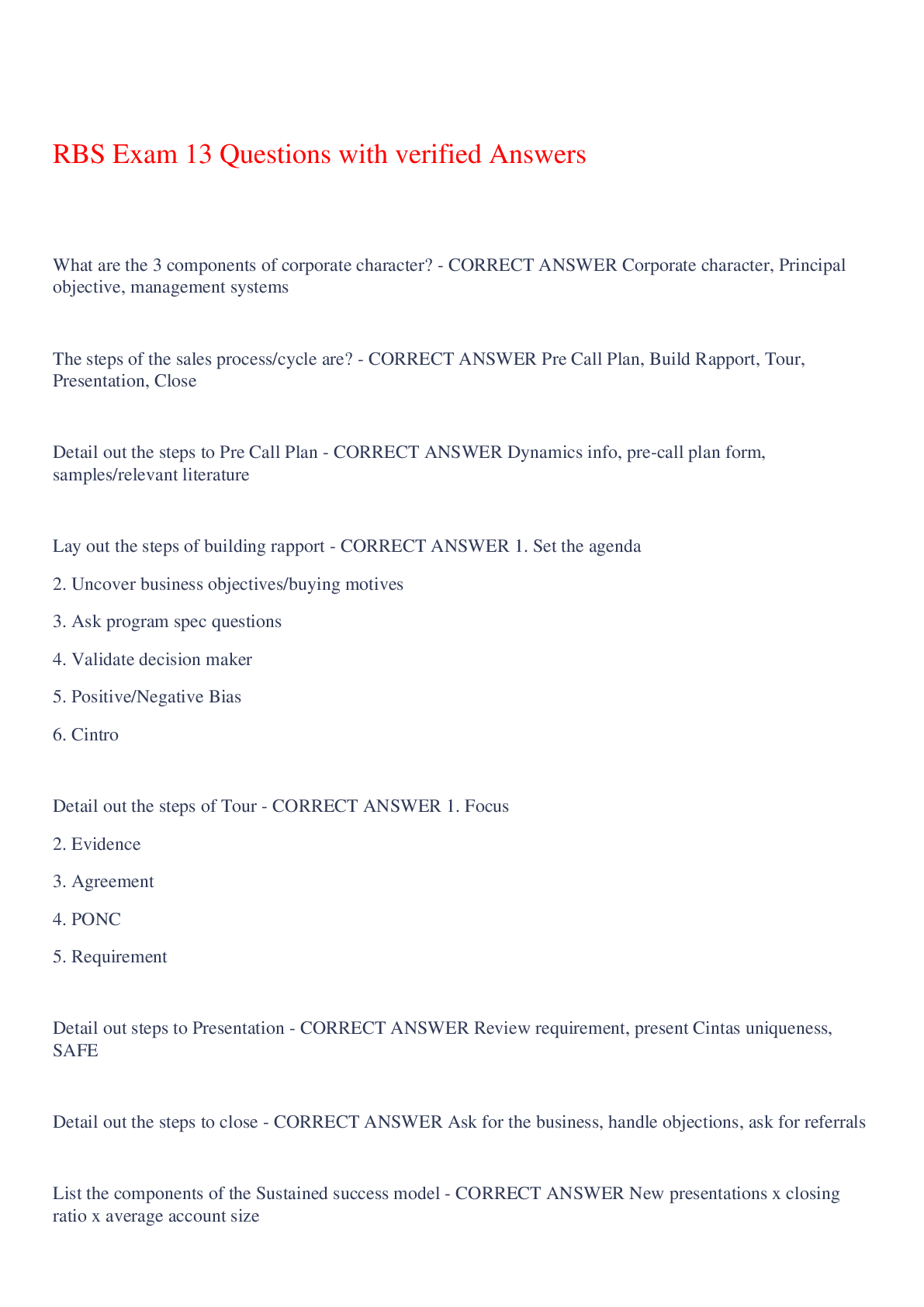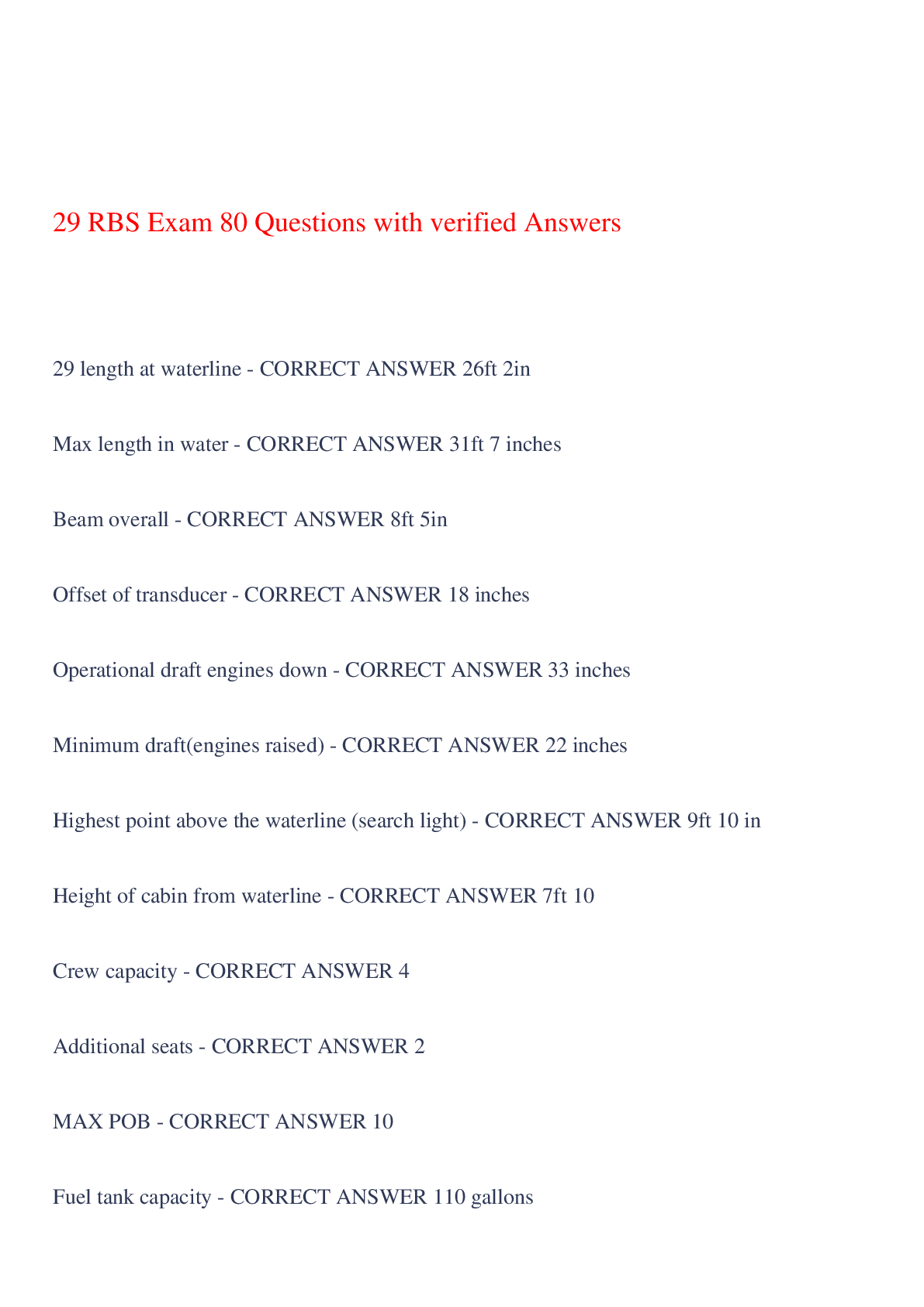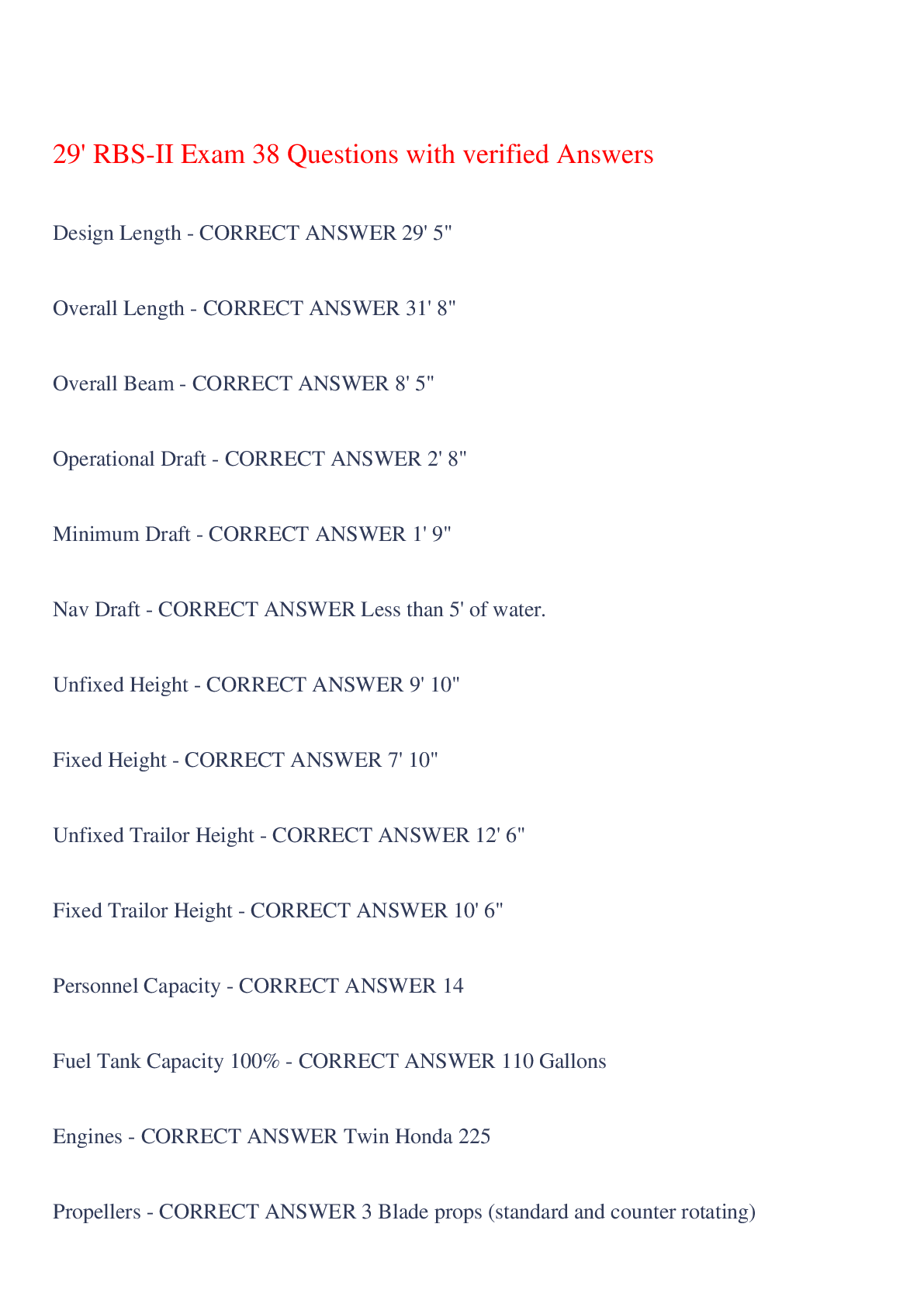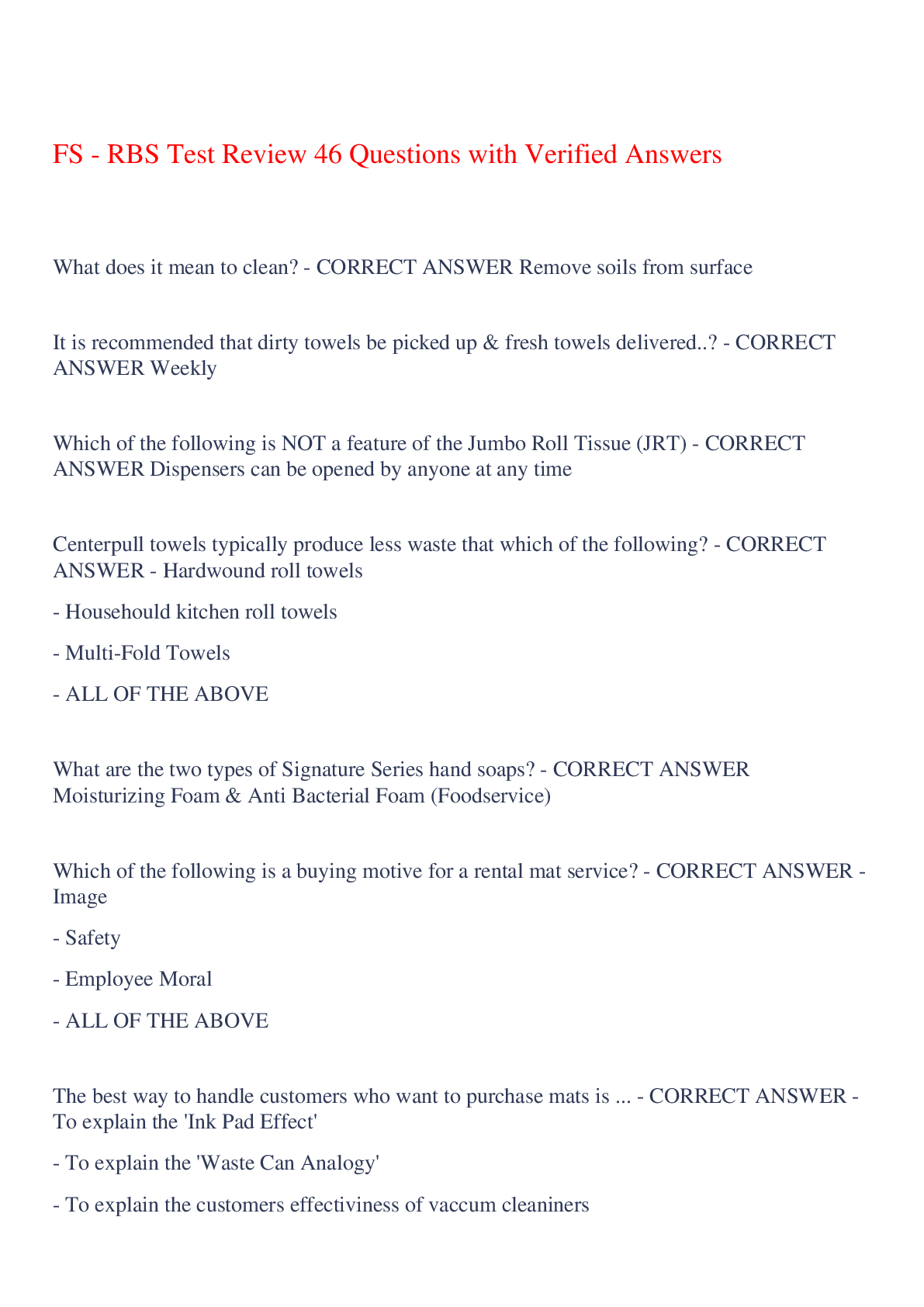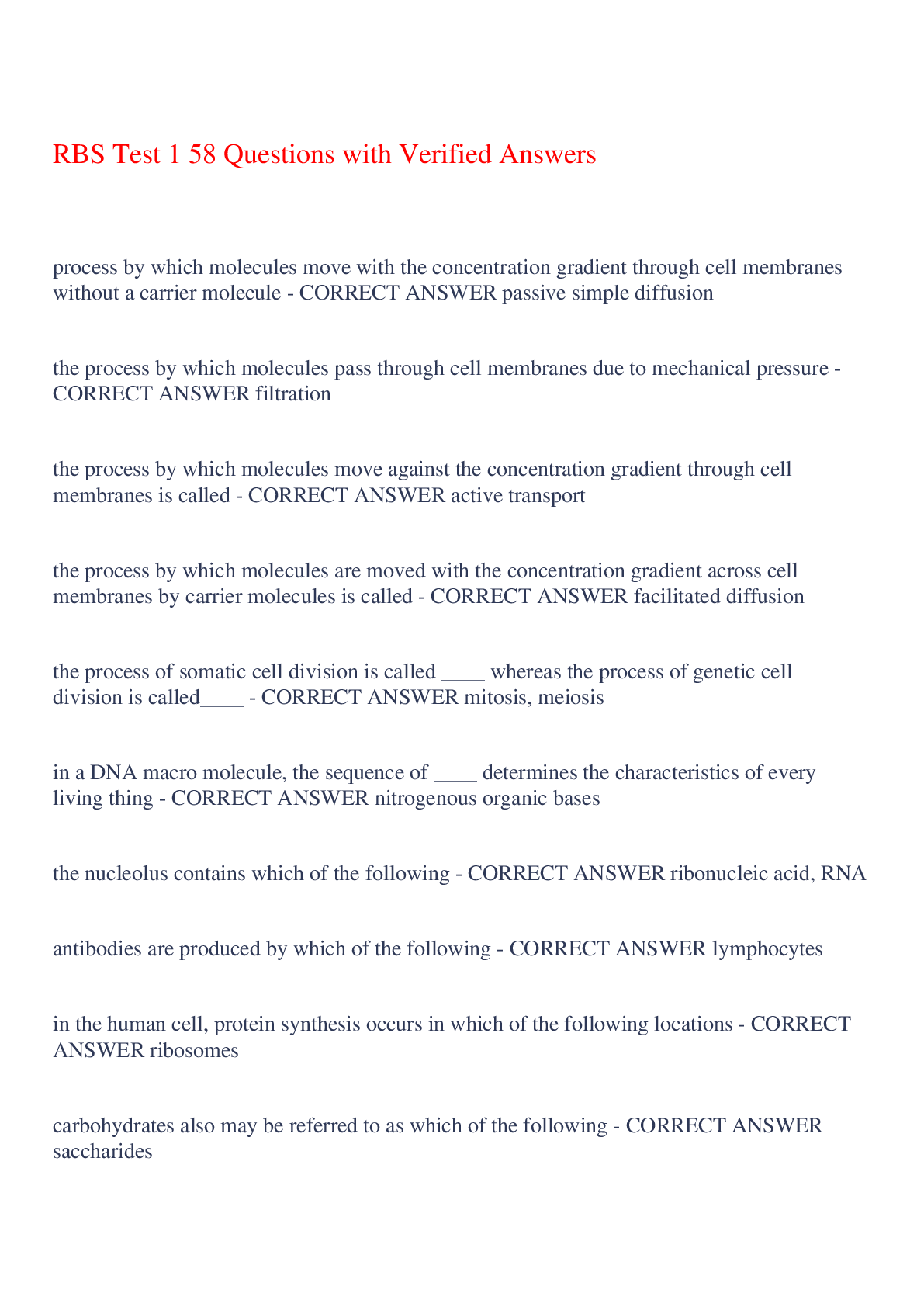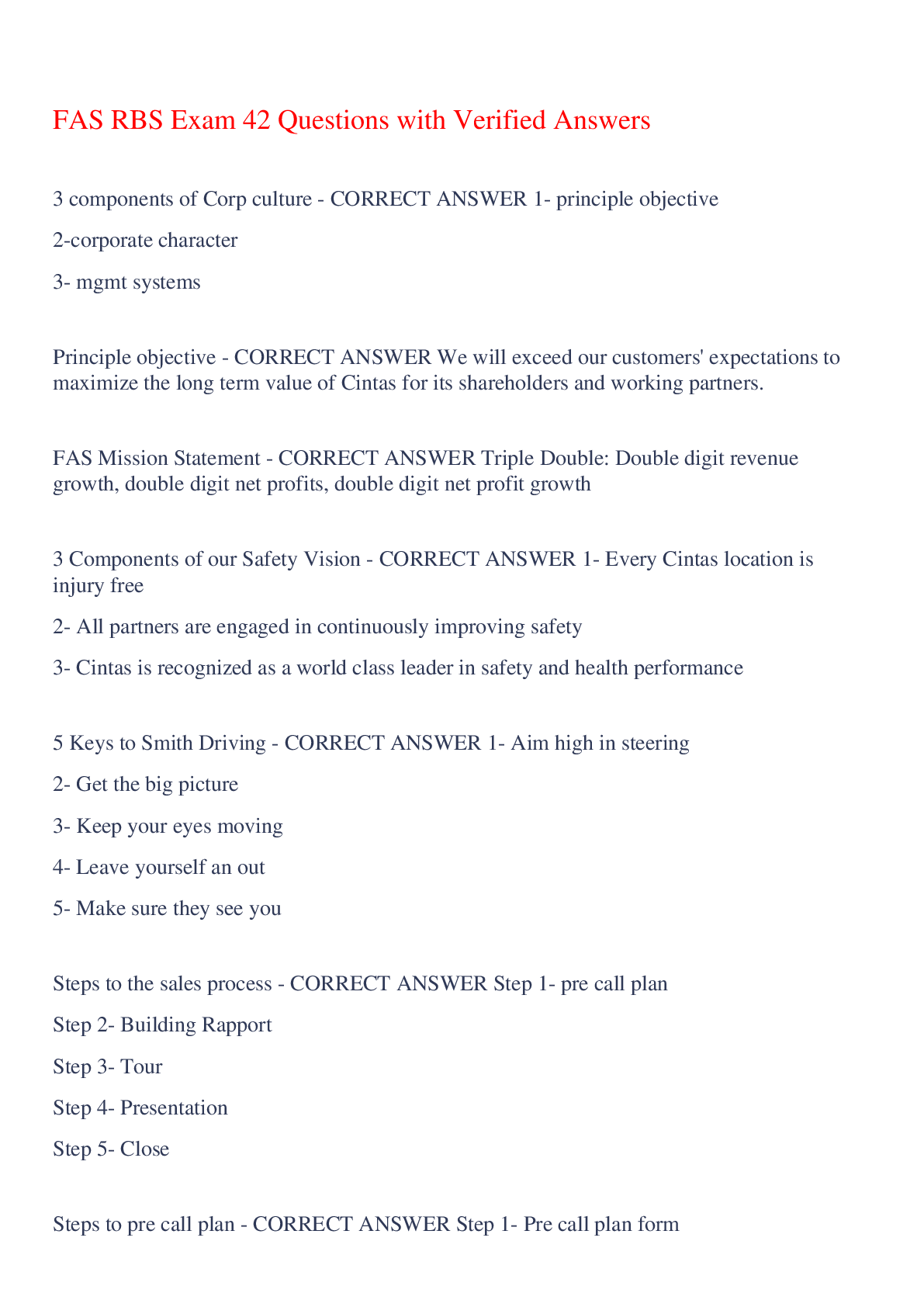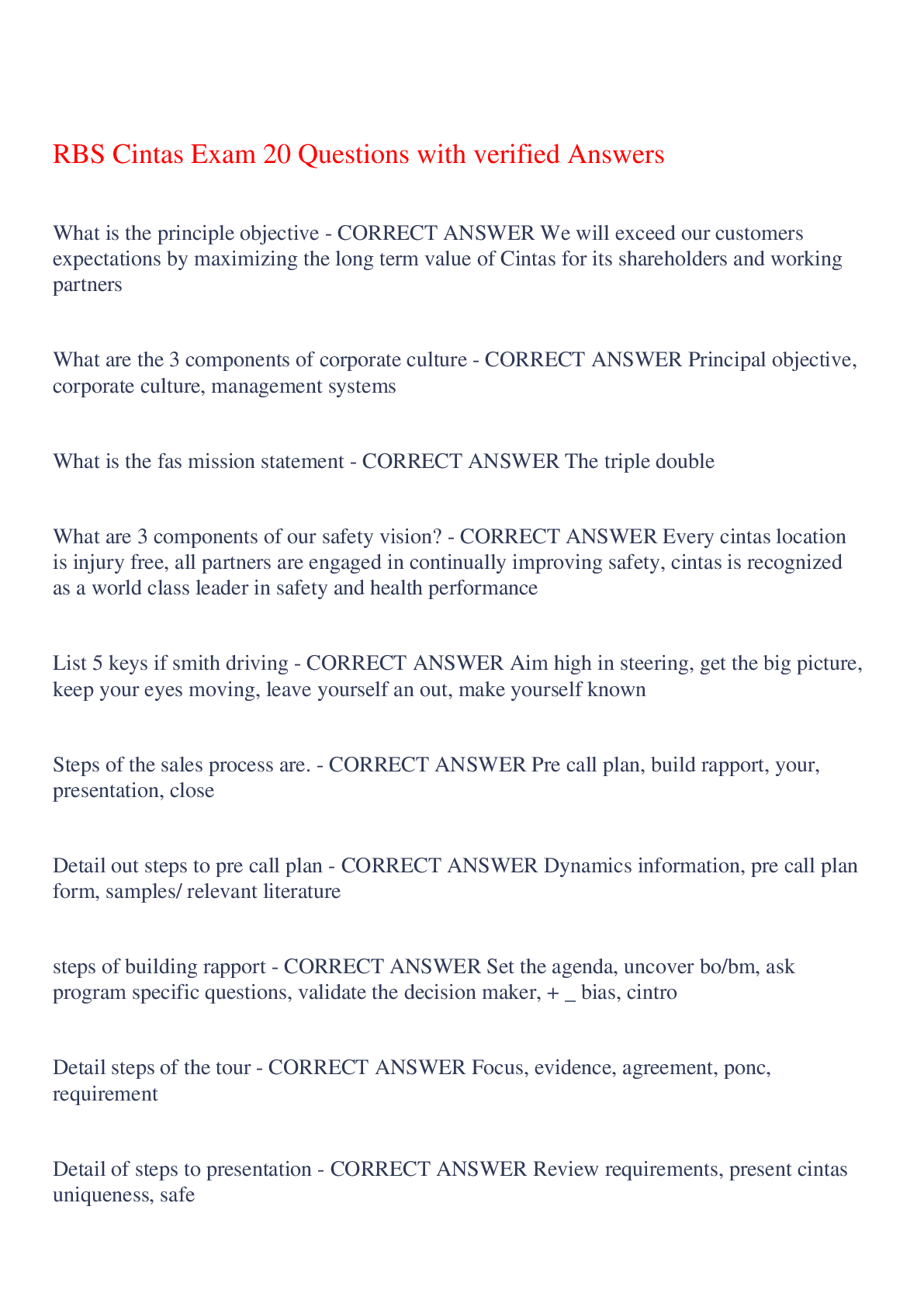NCLEX Exam 3|36 Questions with Verified Answers,100% CORRECT
Document Content and Description Below
NCLEX Exam 3|36 Questions with Verified Answers A patient states, "I have been experiencing complications of diabetes." The nurse needs to direct the patient to gain more information. What is the M... OST appropriate comment or question to elicit additional information? a. "Do you take two injections of insulin to decrease the complications?" b. "Most health care providers recommend diet and exercise to regulate blood sugar." c. "Most complications of diabetes are related to neuropathy." d. "What specific complications have you experienced?" - CORRECT ANSWER d. Requesting specific information regarding complications of diabetes will elicit specific information to guide the nurse in further interview questions and specific assessment techniques. A nurse is preparing an exercise program for a patient who has COPD. Which instructions would the nurse include in a teaching plan for this patient? Select all that apply. a. Instruct the patient to avoid sudden position changes that may cause dizziness. b. Recommend that the patient restrict fluid until after exercising is finished. c. Instruct the patient to push a little further beyond fatigue each session. d. Instruct the patient to avoid exercising in very cold or very hot temperatures. e. Encourage the patient to modify exercise if weak or ill. Recommend that the patient consume a high-carb, low-protein diet. - CORRECT ANSWER a, d. Teaching points for exercising for a patient with COPD include avoiding sudden position changes that may cause dizziness and avoiding extreme temperatures. The nurse should also instruct the patient to provide for adequate hydration, respect fatigue by not pushing to the point of exhaustion, and avoid exercise if weak or ill. Older adults should consume a high-protein, high-calcium, and vitamin D-enriched diet. A nurse is providing range-of-motion exercises for a patient who is recovering from a stroke. During the session, the patient complains that she is "too tired to go on." What would be priority nursing actions for this patient? Select all that apply. a. Stop performing the exercises. b. Decrease the number of repetitions performed. c. Reevaluate the nursing care plan. d. Move to the patient's other side to perform exercises. e. Encourage the patient to finish the exercises and then rest. f. Assess the patient for other symptoms. - CORRECT ANSWER a, c, f. When a patient complains of fatigue during range-of-motion exercises, the nurse should stop the activity, reevaluate the nursing care plan, and assess the patient for further symptoms. The exercises could then be scheduled for times of the day when the patient is feeling more rested, or spaced out at different times of the day. A nurse is ambulating a patient for the first time following surgery for a knee replacement. Shortly after beginning to walk, the patient tells the nurse that she is dizzy and feels like she might fall. Place these nursing actions in the order in which the nurse should perform them to protect the patient: a. Grasp the gait belt. b. Stay with the patient and call for help. c. Place feet wide apart with one foot in front. d. Gently slide patient down to the floor, protecting her head. e. Pull the weight of the patient backward against your body. f. Rock your pelvis out on the side of the patient. - CORRECT ANSWER c, f, a, e, d, b. If a patient being ambulated starts to fall, you should place your feet wide apart with one foot in front, rock your pelvis out on the side nearest the patient, grasp the gait belt, support the patient by pulling her weight backward against your body, gently slide her down your body toward the floor while protecting her head, and stay with the patient and call for help. A nurse caring for patients in a pediatrician's office assesses infants and toddlers for physical developmental milestones. Which patient would the nurse refer to a specialist based on failure to achieve these milestones? a. A 4-month-old infant who is unable to roll over b. A 6-month-old infant who is unable to hold his head up himself c. An 11-month-old infant who cannot walk unassisted d. An 18-month-old toddler who cannot jump - CORRECT ANSWER b. By 5 months, head control is usually achieved. An infant usually rolls over by 6 to 9 months. By 15 months, most toddlers can walk unassisted. By 2 years, most toddlers can jump. A nurse is caring for a patient who has been hospitalized for a spinal cord injury following a motor vehicle accident. Which action would the nurse perform when logrolling the patient to reposition him on his side? a. Have the patient extend his arms outward and cross his legs on top of a pillow. b. Stand at the side of the bed in which the patient will be turned while another nurse gently pushes the patient from the other side. c. Have the patient cross his arms on his chest and place a pillow between his knees. d. Place a cervical collar on the patient's neck and gently roll him to the other side of the bed. - CORRECT ANSWER c. The procedure for logrolling a patient is: (1) Have the patient cross the arms on the chest and place a pillow between the knees; (2) have two nurses stand on one side of the bed opposite the direction the patient will be turned with the third helper standing on the other side and if necessary, a fourth helper at the head of the bed to stabilize the neck; (3) fanfold or roll the drawsheet tightly against the patient and carefully slide the patient to the side of the bed toward the nurses; (4) have one helper move to the other side of the bed so that two nurses are on the side to which the patient is turning; (5) face the patient and have everyone move on a predetermined time, holding the drawsheet taut to support the body, and turn the patient as a unit toward the two nurses. A nurse is caring for a patient in a long-term care facility who has had two urinary tract infections in the past year related to immobility. Which finding would the nurse expect in this patient? a. Improved renal blood supply to the kidneys b. Urinary stasis c. Decreased urinary calcium d. Acidic urine formation - CORRECT ANSWER b. In a nonerect patient, the kidneys and ureters are level. In this position, urine remains in the renal pelvis for a longer period of time before gravity causes it to move into the ureters and bladder, resulting in urinary stasis. Urinary stasis favors the growth of bacteria that may cause urinary tract infections. Regular exercise, not immobility, improves blood flow to the kidneys. Immobility predisposes the patient to increased levels of urinary calcium and alkaline urine, contributing to renal calculi and urinary tract infection, respectively. A nurse is caring for a patient who is hospitalized with pneumonia and is experiencing some difficulty breathing. The nurse most appropriately assists him into which position to promote maximal breathing in the thoracic cavity? a. Dorsal recumbent position b. Lateral position c. Fowler's position d. Sims' position - CORRECT ANSWER c. Fowler's position promotes maximal breathing space in the thoracic cavity and is the position of choice when someone is having difficulty breathing. Lying flat on the back or side or Sims' position would not facilitate respiration and would be difficult for the patient to maintain. A nurse is assisting a postoperative patient with conditioning exercises to prepare for ambulation. Which instructions from the nurse are appropriate for this patient? Select all that apply. a. Do full-body pushups in bed six to eight times daily. b. Breathe in and out smoothly during quadriceps drills. c. Place the bed in the lowest position or use a footstool for dangling. d. Dangle on the side of the bed for 30 to 60 minutes. e. Allow the nurse to bathe the patient completely to prevent fatigue. f. Perform quadriceps two to three times per hour, four to six times a day. - CORRECT ANSWER b, c, f. Breathing in and out smoothly during quadriceps drills maximizes lung inflation. The patient should perform quadriceps two to three times per hour, four to six times a day, or as ordered. The patient should never hold their breath during exercise drills because this places a strain on the heart. Pushups are usually done three or four times a day and involve only the upper body. Dangling for 30 to 60 minutes is unsafe. The nurse should place the bed in the lowest position or use a footstool for dangling. The nurse should also encourage the patient to be as independent as possible to prepare for return to normal ambulation and ADLs. A nurse is caring for a patient who is on bed rest following a spinal injury. In which position would the nurse place the patient's feet to prevent footdrop? a. Supination b. Dorsiflexion c. Hyperextension d. Abduction - CORRECT ANSWER b. For a patient who has footdrop, the nurse should support the feet in dorsiflexion and use a footboard or high-top sneakers to further support the foot. Supination involves lying patients on their back or facing a body part upward, and hyperextension is a state of exaggerated extension. Abduction involves lateral movement of a body part away from the midline of the body. These positions would not be used to prevent footdrop. A nurse is instructing a patient who is recovering from a stroke how to use a cane. Which step would the nurse include in the teaching plan for this patient? a. Support weight on stronger leg and cane and advance weaker foot forward. b. Hold the cane in the same hand of the leg with the most severe deficit. c. Stand with as much weight distributed on the cane as possible. d. Do not use the cane to rise from a sitting position, as this is unsafe. - CORRECT ANSWER a. The proper procedure for using a cane is to (1) stand with weight distributed evenly between the feet and cane; (2) support weight on the stronger leg and the cane and advance the weaker foot forward, parallel with the cane; (3) support weight on the weaker leg and cane and advance the stronger leg forward ahead of the cane; (4) move the weaker leg forward until even with the stronger leg and advance the cane again as in step 2. The patient should keep the cane within easy reach and use it for support to rise safely from a sitting position. A patient has a fractured left leg, which has been casted. Following teaching from the physical therapist for using crutches, the nurse reinforces which teaching point with the patient? a. Use the axillae to bear body weight. b. Keep elbows close to the sides of the body. c. When rising, extend the uninjured leg to prevent weight bearing. d. To climb stairs, place weight on affected leg first. - CORRECT ANSWER b. The patient should keep the elbows at the sides, prevent pressure on the axillae to avoid damage to nerves and circulation, extend the injured leg to prevent weight bearing when rising from a chair, and advance the unaffected leg first when climbing stairs. A nurse working in a long-term care facility uses proper patient care ergonomics when handling and transferring patients to avoid back injury. Which action should be the focus of these preventive measures? a. Carefully assessing the patient care environment b. Using two nurses to lift a patient who cannot assist c. Wearing a back belt to perform routine duties d. Properly documenting the patient lift - CORRECT ANSWER a. Preventive measures should focus on careful assessment of the patient care environment so that patients can be moved safely and effectively. Using lifting teams and assistive patient handling equipment rather than two nurses to lift increases safety. The use of a back belt does not prevent back injury. The methods used for safe patient handling and movement should be documented but are not the primary focus of interventions related to injury prevention. A nurse is assisting a patient who is 2 days postoperative from a cesarean section to sit in a chair. After assisting the patient to the side of the bed and to stand up, the patient's knees buckle and she tells the nurse she feels faint. What is the appropriate nursing action? a. Wait a few minutes and then continue the move to the chair. b. Call for assistance and continue the move with the help of another nurse. c. Lower the patient back to the side of the bed and pivot her back into bed. d. Have the patient sit down on the bed and dangle her feet before moving. - CORRECT ANSWER c. If a patient becomes faint and knees buckle when moving from bed to a chair, the nurse should not continue the move to the chair. The nurse should lower the patient back to the side of the bed, pivot her back into bed, cover her, and raise the side rails. Assess the patient's vital signs and for the presence of other symptoms. Another attempt should be made with the assistance of another staff member if vital signs are stable. Instruct the patient to remain in the sitting position on the side of the bed for several minutes to allow the circulatory system to adjust to a change in position, and avoid hypotension related to a sudden change in position. During an interaction with a patient diagnosed with epilepsy, a nurse notes that the patient is silent after communicating the nursing care plan. What would be appropriate nurse responses in this situation? Select all that apply. a. Fill the silence with lighter conversation directed at the patient. b. Use the time to perform the care that is needed uninterrupted. c. Discuss the silence with the patient to ascertain its meaning. d. Allow the patient time to think and explore inner thoughts. e. Determine if the patient's culture requires pauses between conversation. f. Arrange for a counselor to help the patient cope with emotional issues. - CORRECT ANSWER c, d, e. The nurse can use silence appropriately by taking the time to wait for the patient to initiate or to continue speaking. During periods of silence, the nurse should reflect on what has already been shared and observe the patient without having to concentrate simultaneously on the spoken word. In due time, the nurse might discuss the silence with the patient in order to understand its meaning. Also, the patient's culture may require longer pauses between verbal communication. Fear of silence sometimes leads to too much talking by the nurse, and excessive talking tends to place the focus on the nurse rather than on the patient. The nurse should not assume silence requires a consult with a counselor. An RN working in a hospital setting is responsible for patient assessment. For which patient would the nurse perform a focused assessment? a. A patient newly admitted to the unit b. A patient with diabetes who develops secondary hypertension c. A patient who presents with signs of acute respiratory distress syndrome (ARDS) d. A patient who is recovering from abdominal surgery with no complications - CORRECT ANSWER A nurse caring for patients in a long-term care facility is performing a functional assessment of a new patient. Which questions would the nurse ask? Select all that apply. a. Are you able to dress yourself? b. Do you have a history of smoking? c. What is the problem for which you are seeking care? d. Do you prepare your own meals? e. Do you manage your own finances? f. Whom do you rely on for support? - CORRECT ANSWER A nurse is assessing a patient's eyes for extraocular movements. Which action correctly describes a step the nurse would take when performing this test? a. Ask the patient to sit about 3 ft away facing the nurse. b. Keep a penlight about 1 ft from the patient's face and move it slowly through the cardinal positions. c. Move a penlight in a circular motion in front of the patient's eyes. d. Ask the patient to cover one eye with a hand or index card. - CORRECT ANSWER Which actions would the nurse perform when using the technique of palpation during the physical assessment of a patient? Select all that apply. a. The nurse compares the patient's bilateral body parts for symmetry. b. The nurse takes a patient's pulse. c. The nurse touches a patient's skin to test for turgor. d. The nurse checks a patient's lymph nodes for swelling. e. The nurse taps a patient's body to check the organs. f. The nurse uses a stethoscope to listen to a patient's heart sounds. - CORRECT ANSWER When inspecting the skin of a patient who has cirrhosis of the liver, the nurse notes that the skin has a yellow tint. What would the nurse document related to this finding? a. Jaundice b. Cyanosis c. Erythema d. Pallor - CORRECT ANSWER The nurse places a patient in the dorsal recumbent position during a physical assessment. Which nursing actions could the nurse perform with the patient in this position? Select all that apply. a. Assessing the abdomen b. Taking peripheral pulses c. Performing a breast examination d. Auscultating the heart e. Assessing vital signs f. Assessing balance and gait - CORRECT ANSWER A patient who injured the spine in a motorcycle accident is receiving rehabilitation services in a short-term rehabilitation center. The nurse caring for the patient correctly tells the aide not to place the patient in which position? a. Side-lying b. Fowler's c. Sims' d. Prone - CORRECT ANSWER d. The prone position is contraindicated in patients who have spinal problems because the pull of gravity on the trunk when the patient lies prone produces a marked lordosis or forward curvature of the lumbar spine. A nurse is using the Katz Index of Independence in Activities of Daily Living (ADLs) to assess the mobility of a hospitalized patient. During the patient interview, the nurse documents the following patient data: "Patient bathes self completely but needs help with dressing. Patient toilets independently and is continent. Patient needs help moving from bed to chair. Patient follows directions and can feed self." Based on this data, which score would the patient receive on the Katz index? a. 2 b. 4 c. 5 d. 6 - CORRECT ANSWER b. The total score for this patient is 4. On the Katz Index of Independence in ADLs, one point is awarded for independence in each of the following activities: bathing, dressing, toileting, transferring, continence, and feeding. During rounds, a charge nurse hears the patient care technician yelling loudly to a patient regarding a transfer from the bed to chair. Upon entering the room, what is the nurse's BEST response? a. "You need to speak to the patient quietly so you don't disturb the other patients." b. "Let me help you with your transfer technique." c. "When you are finished, be sure to apologize for your rough demeanor." d. "When your patient is safe and comfortable, meet me at the desk." - CORRECT ANSWER d. The charge nurse should direct the patient care technician to determine the patient's safety. Then the nurse should address any concerns regarding the patient care technician's communication techniques privately. The nurse should direct the patient care technician on aspects of therapeutic communication. A public health nurse is leaving the home of a young mother who has a special needs baby. The neighbor states, "How is she doing, since the baby's father is no help?" What is the nurse's BEST response to the neighbor? a. "New mothers need support." b. "The lack of a father is difficult." c. "How are you today?" d. "It is a very sad situation." - CORRECT ANSWER a. The nurse must maintain confidentiality when providing care. The statement "New mothers need support" is a general statement that all new parents need help. The statement is not judgmental of the family's roles. A 3-year-old child is being admitted to a medical division for vomiting, diarrhea, and dehydration. During the admission interview, the nurse should implement which communication techniques to elicit the most information from the parents? a. The use of reflective questions b. The use of closed questions c. The use of assertive questions d. The use of clarifying questions - CORRECT ANSWER d. The use of the clarifying question or comment allows the nurse to gain an understanding of a patient's comment. When used properly, this technique can avert possible misconceptions that could lead to an inappropriate nursing diagnosis. The reflective question technique involves repeating what the person has said or describing the person's feelings. Open-ended questions encourage free verbalization and expression of what the parents believe to be true. Assertive behavior is the ability to stand up for yourself and others using open, honest, and direct communication. A nurse enters a patient's room and examines the patient's IV fluids and cardiac monitor. The patient states, "Well, I haven't seen you before. Who are you?" What is the nurse's BEST response? a. "I'm just the IV therapist checking your IV." b. "I've been transferred to this division and will be caring for you." c. "I'm sorry, my name is John Smith and I am your nurse." d. "My name is John Smith, I am your nurse and I'll be caring for you until 11 PM." - CORRECT ANSWER d. The nurse should identify himself, be sure the patient knows what will be happening, and the time period he will be with his patient. A nurse enters the room of a patient with cancer. The patient is crying and states, "I feel so alone." Which response by the nurse is the most therapeutic action? a. The nurse stands at the patient's bedside and states, "I understand how you feel. My mother said the same thing when she was ill." b. The nurse places a hand on the patient's arm and states, "You feel so alone." c. The nurse stands in the patient's room and asks, "Why do you feel so alone? Your wife has been here every day." d. The nurse holds the patient's hand and asks, "What makes you feel so alone?" - CORRECT ANSWER d. The use of touch conveys acceptance, and the implementation of an open-ended question allows the patient time to verbalize freely. A nurse caring for a patient who is hospitalized following a double mastectomy is preparing a discharge plan for the patient. Which action should be the focus of this termination phase of the helping relationship? a. Determining the progress made in achieving established goals b. Clarifying when the patient should take medications c. Reporting the progress made in teaching to the staff d. Including all family members in the teaching session - CORRECT ANSWER a. The termination phase occurs when the conclusion of the initial agreement is acknowledged. Discharge planning coordinates with the termination phase of a helping relationship. The nurse should determine the progress made in achieving the goals related to the patient's care. A nursing student is nervous and concerned about working at a clinical facility. Which action would BEST decrease anxiety and ensure success in the student's provision of patient care? a. Determining the established goals of the institution b. Ensuring that verbal and nonverbal communication is congruent c. Engaging in self-talk to plan the day and decrease fear d. Speaking with fellow colleagues about how they feel - CORRECT ANSWER c. By engaging in self-talk, or intrapersonal communication, the nursing student can plan her day and enhance her clinical performance to decrease fear and anxiety. A nurse in the rehabilitation division states to the head nurse: "I need the day off and you didn't give it to me!" The head nurse replies, "Well, I wasn't aware you needed the day off, and it isn't possible since staffing is so inadequate." Instead of this exchange, what communication by the nurse would have been more effective? a. "I placed a request to have 8th of August off, but I'm working and I have a doctor's appointment." b. "I would like to discuss my schedule with you. I requested the 8th of August off for a doctor's appointment. Could I make an appointment?" c. "I will need to call in on the 8th of August because I have a doctor's appointment." d. "Since you didn't give me the 8th of August off, will I need to find someone to work for me?" - CORRECT ANSWER b. Effective communication by the sender involves the implementation of nonthreatening information by showing respect to the receiver. The nurse should identify the subject of the meeting and be sure it occurs at a mutually agreed upon time. During a nursing staff meeting, the nurses resolve a problem of delayed documentation by agreeing unanimously that they will make sure all vital signs are reported and charted within 15 minutes following assessment. This is an example of which characteristics of effective communication? Select all that apply. a. Group decision making b. Group leadership c. Group power d. Group identity e. Group patterns of interaction f. Group cohesiveness - CORRECT ANSWER a, d, e, f. Solving problems involves group decision making; ascertaining that the staff completes a task on time and that all members agree the task is important is a characteristic of group identity; group patterns of interaction involve honest communication and member support; and cohesiveness occurs when members generally trust each other, have a high commitment to the group, and a high degree of cooperation. Group leadership occurs when groups use effective styles of leadership to meet goals; with group power, sources of power are recognized and used appropriately to accomplish group outcomes. A nurse notices a patient is walking to the bathroom with a stooped gait, facial grimacing, and gasping sounds. Based on these nonverbal clues, for which condition would the nurse assess? a. Pain b. Anxiety c. Depression d. Fluid volume deficit - CORRECT ANSWER a. A patient who presents with nonverbal communication of a stooped gait, facial grimacing, and gasping sounds is most likely experiencing pain. The nurse should clarify this nonverbal behavior. A nursing student is preparing to administer morning care to a patient. What is the MOST important question that the nursing student should ask the patient about personal hygiene? a. "Would you prefer a bath or a shower?" b. "May I help you with a bed bath now or later this morning?" c. "I will be giving you your bath. Do you use soap or shower gel?" d. "I prefer a shower in the evening. When would you like your bath?" - CORRECT ANSWER b. The nurse should ask permission to assist the patient with a bath. This allows for consent to assist the patient with care that invades the patient's private zones. A nurse is providing instruction to a patient regarding the procedure to change a colostomy bag. During the teaching session, the patient asks, "What type of foods should I avoid to prevent gas?" The patient's question allows for what type of communication on the nurse's part? a. A closed-ended answer b. Information clarification c. The nurse to give advice d. Assertive behavior - CORRECT ANSWER b. The patient's question allows the nurse to clarify information that is new to the patient or that requires further explanation. When interacting with a patient, the nurse answers, "I am sure everything will be fine. You have nothing to worry about." This is an example of what type of inappropriate communication technique? a. Cliché b. Giving advice c. Being judgmental d. Changing the subject - CORRECT ANSWER a. Telling a patient that everything is going to be all right is a cliché. This statement gives false assurance and gives the patient the impression that the nurse is not interested in the patient's condition. [Show More]
Last updated: 7 months ago
Preview 1 out of 14 pages
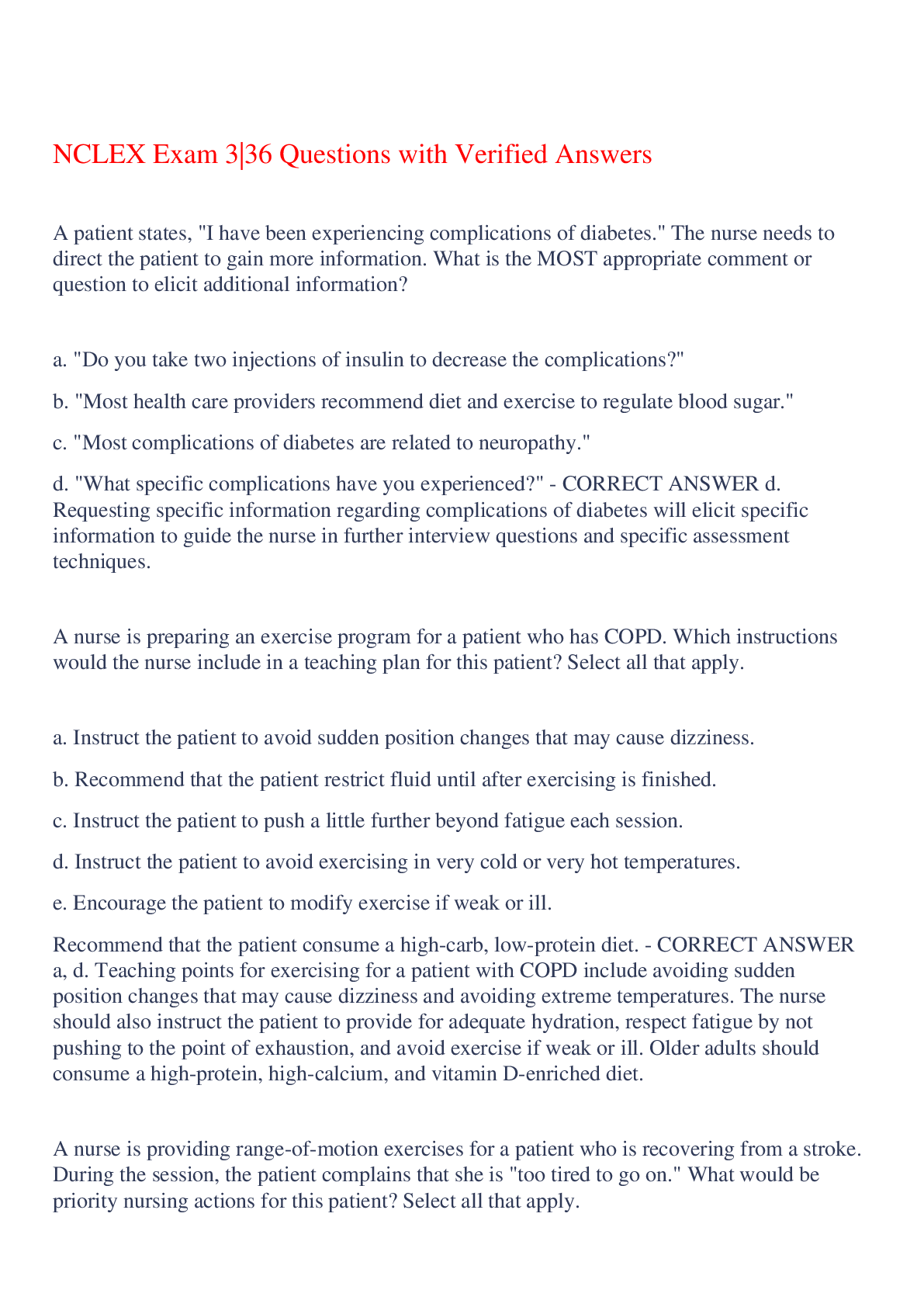
Buy this document to get the full access instantly
Instant Download Access after purchase
Add to cartInstant download
We Accept:

Reviews( 0 )
$8.00
Document information
Connected school, study & course
About the document
Uploaded On
Nov 14, 2023
Number of pages
14
Written in
Additional information
This document has been written for:
Uploaded
Nov 14, 2023
Downloads
0
Views
47















